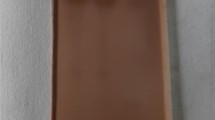Abstract
Ceralure or trimedlure polymeric TNO panels in C&C traps were compared for attractancy by the capture of male Mediterranean fruit flies, Ceratitis capitata (Wiedemann). This study contrasts the effectiveness of ceralure with trimedlure, the former of which is an iodo-analog of trimedlure. Field tests in Hawaii with released flies showed that the active ceralure B1 isomer in a commercial mixture of ceralure isomers consistently caught as many male flies as active trimedlure C isomer in a commercial mixture of trimedlure isomers at one-half the molar quantity of trimedlure C. These panels caught 6.4 and 5.2 times, for ceralure and trimedlure, respectively, more than the standard 2 g trimedlure AgriSense aged plug over a 26-week period. The persistence of ceralure is demonstrated by residual analyses of aged panels that revealed the presence of 2.75 times more ceralure than trimedlure in panels after 130 days of field exposure.
Similar content being viewed by others
REFERENCES
Anonymous. 1996a. http://www.aphis.usda.gov/oa/medfly.html and http://www.ars–grin.gov:80/ars/Beltsville/barc/psi/icel/icel.html
Anonymous. January 1996b. To zap medflies—red dye, updated traps. Agric. Res. 44:20–22.
Avery, J. W., Chambers, D. L., Cunningham, R. T., and Leonhardt, B. A. 1994. Use of ceralure and trimedlure in Mediterranean fruit fly (Diptera: Tephritidae) mass–trapping tests. J. Entomol. Sci. 29:543–556.
Beroza, M., Green, N., Gertler, S. I., Steiner, L. F., and Miyashita, D. M. 1961. New attractants for the Mediterranean fruit fly. J. Agric. Food Chem. 9:361–365.
Cochran, W. G., and Cox, G. M. 1957. Experimental Designs, 2nd ed. John Wiley & Sons, New York.
Doolittle, R. E., Cunningham, R. T., McGovern, T. P., and Sonnet, P. E. 1991. Trimedlure enantiomers: Differences in attraction for Mediterranean fruit fly, Ceratitis capitata (Wied.) (Diptera: Tephritidae). J. Chem. Ecol. 17:475–484.
Fisher, R. A. 1966. The Design of Experiments, 8th ed. Hafner Press, New York.
Harris, E. J., Nadagawa, S., and Urago, T. 1971. Sticky traps for detection and survey of three tephritids. J. Econ. Entomol. 64:62–65.
Leonhardt, B. A., Rice, R. E., Harte, E. M., and Cunningham, R. T. 1984. Evaluation of dispensers containing trimedlure, the attractant for the Mediterranean fruit Fly (Diptera: Tephritidae). J. Econ. Entomol. 77:744–749.
Leonhardt, B. A., Cunningham, R. T., Harte, E. M., and McGovern, T. P. 1986. Effect of additives on the evaporation of the most active isomer of trimedlure, the attractant for Ceratitis capitata (Diptera: Tephritidae). J. Econ. Entomol. 79:1050–1054.
Leonhardt, B. A., Cunningham, R. T., Rice, R. E., Harte, E. M., and McGovern, T. P. 1987. Performance of controlled–release formulations of trimedlure to attract the Mediterranean fruit fly, Ceratitis capitata. Entomol. Exp. Appl. 44:45–51.
Leonhardt, B. A., Cunningham, R. T., Rice, R. E., Harte, E. M., and Hendrichs, J. 1989. Design, effectiveness, and performance criteria of dispenser formulations of trimedlure, an attractant of the Mediterranean fruit fly (Diptera: Tephritidae). J. Econ. Entomol. 82:860–867.
Leonhardt, B. A., Cunningham, R. T., Chambers, D. L., Avery, J. W., and Harte, E. M. 1994. Controlled–release panel traps for the Mediterranean fruit fly (Diptera: Tephritidae). J. Econ. Entomol. 87:1217–1223.
Leonhardt, B. A., Cunningham, R. T., Avery, J. W., DeMilo, A. B., and Warthen, J. D., Jr. 1996. Comparison of ceralure and trimedlure attractants for the male Mediterranean fruit fly (Diptera: Tephritidae). J. Entomol. Sci. 31:183–190.
Liquido, N. J., Shinoda, L. A., and Cunningham, R. T. 1991. Host plants of the Mediterranean fruit Fly: An annotated world review. Misc. Publ. Entomol. Soc. Am. 77:1–52.
McGovern, T. P., and Beroza, M. 1966. Structure of the four isomers of the insect attractant trimedlure. J. Org. Chem. 31:1472–1477.
McGovern, T. P., and Cunningham, R. T. 1987. New medfly attractants: Halogen analogs of trimedlure. National Conference of the Entomological Society of America, Boston, Massachusetts, Paper 1283, November 29–December 3.
McGovern, T. P., Beroza, M., Ohinata, K., Miyashita, D., and Steiner, L. F. 1966. Volatility and attractiveness to the Mediterranean fruit fly of trimedlure and its isomers, and a comparison of its volatility with that of seven other insect attractants. J. Econ. Entomol. 59:1450–1455.
McGovern, T. P., Cunningham, R. T., and Leonhardt, B. A. 1986. cis–Trimedlure: Attraction for the Mediterranean fruit fly (Diptera: Tephritidae) and isomeric structural assignments. J. Econ. Entomol. 79:98–102.
McGovern, T. P., Cunningham, R. T., and Leonhardt, B. A. 1987. Attractiveness of trans–trimedlure and its four isomers in field tests with the Mediterranean fruit fly (Diptera: Tephritidae). J. Econ. Entomol. 80:617–620.
McGovern, T. P., Warthen, J. D., Jr., and Cunningham, R. T. 1990. Relative attraction of the Mediterranean fruit fly (Diptera: Tephritidae) to the eight isomers of trimedlure. J. Econ. Entomol. 83:1350–1354.
Rice, R. E., Cunningham, R. T., and Leonhardt, B. A. 1984. Weathering and efficacy of trimedlure dispensers for attraction of Mediterranean fruit flies (Diptera: Tephritidae). J. Econ. Entomol. 77:750–756.
Sonnet, P. E., McGovern, T. P., and Cunningham, R. T. 1984. Enantiomers of the biologically active components of the insect attractant trimedlure. J. Org. Chem. 49:4639–4643.
Warthen, J. D., Jr., Cunningham, R. T., DeMilo, A. B., and Spencer, S. 1994. trans–Ceralure isomers: Differences in attraction for Mediterranean fruit fly, Ceratitis capitata (Wied.) (Diptera: Tephritidae). J. Chem. Ecol. 20:569–578.
Warthen, J. D., Cunningham, R. T., Leonhardt, B. A., Cook, J. M., Avery, J. W., and Harte, E. M. 1997. Improved controlled–release formulations for a new trap design for male Mediterranean fruit flies: the C&C trap. J. Chem. Ecol. 23:1471–1486.
Author information
Authors and Affiliations
Rights and permissions
About this article
Cite this article
Warthen, J.D., Cunningham, R.T., Leonhardt, B.A. et al. Comparison of Ceralure and Trimedlure Controlled-Release Formulations for Male Mediterranean Fruit Flies in C&C Traps. J Chem Ecol 24, 1305–1314 (1998). https://doi.org/10.1023/A:1021270615153
Issue Date:
DOI: https://doi.org/10.1023/A:1021270615153




